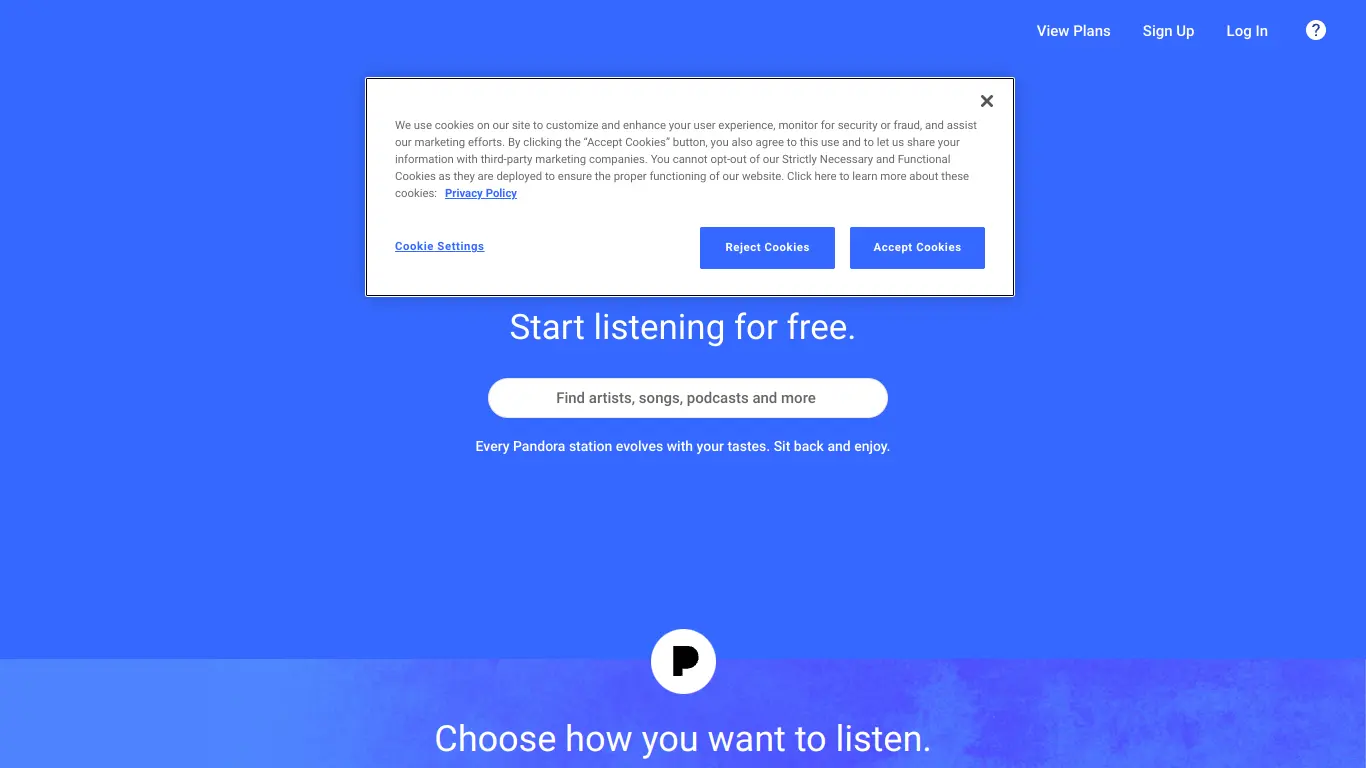Pandora uses the Music Genome Project to create personalized radio stations that evolve with your musical preferences.
In the evolving landscape of digital entertainment, finding the perfect music streaming service that understands your unique taste can feel like an endless quest. If you’ve ever found yourself skipping through songs endlessly or feeling frustrated by algorithms that just don’t “get” your musical preferences, you’re not alone. Music discovery should be effortless and enjoyable, not a chore. That’s where Pandora comes in – a pioneering platform that’s been revolutionizing how we discover and enjoy music for nearly two decades.
Introduction to Pandora
What is Pandora and its Purpose?
Pandora is one of America’s longest-running and most recognized music streaming services. Founded in 2000 and launched publicly in 2005, Pandora was built around a revolutionary concept: the Music Genome Project. This ambitious undertaking involved music experts analyzing songs based on 450+ musical attributes to create a sophisticated recommendation system that truly understands music at its core.
Unlike traditional streaming platforms that simply suggest popular tracks or artist-based recommendations, Pandora’s purpose is to create personalized listening experiences through custom radio stations that evolve with your preferences. The platform aims to bring the joy of music discovery back to listeners by introducing them to new artists and songs that align with their established tastes.
Pandora’s mission statement puts it perfectly: “Our mission is to enrich lives by enabling listeners to enjoy music they know and discover music they’ll love.”
Who is Pandora Designed For?
Pandora caters to a wide audience of music enthusiasts:
- Casual listeners who want background music without the hassle of curating playlists
- Music discoverers seeking to expand their musical horizons with new artists
- Commuters and workers who want hands-free listening experiences
- Advertisement-tolerant users willing to experience ads for free access
- Premium subscribers looking for higher quality audio and additional features
- Artists and bands who want exposure to new potential fans
The platform is particularly popular among Americans who appreciate its radio-style approach to music streaming. With approximately 55.9 million monthly active users as of 2022, Pandora remains one of the most significant players in the U.S. streaming market, despite increased competition.
Getting Started with Pandora: How to Use It
Getting started with Pandora is refreshingly straightforward:
- Create an account: Visit Pandora.com or download the mobile app from your device’s app store. Sign up using your email or connect through social media accounts.
- Start a station: Enter an artist, song, composer, or genre you enjoy. Pandora will create a station based on that selection, playing music with similar qualities.
- Train your stations: As songs play, provide feedback using the thumbs up/down buttons. This crucial step helps Pandora refine its understanding of your preferences.
- Explore features: Discover curated playlists, podcasts, and genre stations in the “Browse” section.
- Consider upgrading: Evaluate the free version’s limitations (advertisements, limited skips) and determine if a premium subscription aligns with your needs.
The beauty of Pandora lies in its simplicity: start with what you know you like, provide feedback, and watch as the platform creates a personalized audio journey that evolves with your taste.
Pandora’s Key Features and Benefits
Core Functionalities of Pandora
Pandora distinguishes itself through several core features that form the backbone of its service:
- The Music Genome Project: The proprietary technology analyzes music using hundreds of musical attributes to create truly meaningful connections between songs. Each track in Pandora’s extensive library has been manually analyzed by music experts.
- Custom Radio Stations: Create stations based on artists, songs, genres, or activities that evolve over time with your feedback.
- Thumbs Up/Down System: This simple yet effective feedback mechanism allows users to train the algorithm to their preferences.
- Modes Feature: Customize your stations further with options like “Discover” (more variety), “Deep Cuts” (less-known tracks from artists), or “Crowd Faves” (popular songs).
- Podcasts and Non-Music Content: Beyond music, Pandora offers podcast streaming integrated into the same platform.
- Pandora Stories: A unique feature combining music with voice commentary from artists and creators.
- SiriusXM Integration: Following acquisition, Pandora now offers some SiriusXM content and features.
Advantages of Using Pandora
Pandora offers several distinct advantages for music enthusiasts:
- Effortless Discovery: The platform excels at introducing users to new music that genuinely matches their taste, requiring minimal effort from the listener.
- Set-and-Forget Convenience: Perfect for situations where you want continuous music without having to manually select each track.
- Music Education: Through its sophisticated analysis, users gain deeper insight into musical characteristics they prefer.
- Cross-Platform Availability: Available across numerous devices including smartphones, tablets, smart speakers, automotive systems, and web browsers.
- Personalization Depth: With nearly two decades of development, Pandora’s recommendation engine incorporates nuances that newer systems may lack.
- Free Tier Accessibility: The ad-supported version provides complete access to the core radio functionality.
Main Use Cases and Applications
Pandora serves diverse listening scenarios:
📱 Personal Entertainment
- Background music while working or studying
- Party playlists that require minimal management
- Workout music that maintains energy without interruption
🚗 In-Vehicle Entertainment
- Commute soundtracks through car infotainment systems
- Road trip music discovery without driver distraction
🏠 Smart Home Integration
- Voice-controlled music through Amazon Alexa, Google Assistant, and other smart speakers
- Multi-room audio synchronized across different devices
🎵 Music Education
- Exploring specific genres in depth
- Understanding musical elements that define certain styles
🎧 Specialized Listening
- Seasonal and holiday music collections
- Mood-based stations for relaxation, focus, or energy
According to industry statistics, the average Pandora user listens for approximately 20 hours per month, highlighting its effectiveness at maintaining engagement through its personalization capabilities.
Exploring Pandora’s Platform and Interface
User Interface and User Experience
Pandora’s interface strikes a careful balance between simplicity and functionality:
Mobile App (iOS/Android)
The mobile experience prioritizes station-based listening with intuitive navigation:
- Clean, visually appealing player with album artwork prominently displayed
- Bottom navigation bar for quick access to Home, My Collection, and Search
- Minimal taps required to start listening
- Thumbs up/down controls easily accessible during playback
- Recently played tracks and stations readily available
Web Player
The browser-based experience offers more screen real estate for discovery:
- Sidebar navigation for quick access to key sections
- Larger discovery sections with visual browsing options
- More detailed information about currently playing content
- Enhanced playlist management capabilities
Smart Devices
On devices with limited displays or voice-only interfaces:
- Streamlined voice commands for station creation and control
- Clear audio prompts to confirm actions
- Simplified controls that maintain core functionality
Pandora’s UX philosophy clearly emphasizes getting users to their music quickly with minimal friction. The interface has evolved substantially from its earlier, more basic designs, but maintains focus on its radio-style experience even as it has added on-demand features for premium subscribers.
Platform Accessibility
Pandora demonstrates impressive platform versatility, making it accessible across numerous devices and systems:
Device Availability:
- 📱 iOS and Android smartphones and tablets
- 💻 Web browsers on Mac and PC
- 📺 Smart TVs (Samsung, LG, Vizio, etc.)
- 🔊 Smart speakers (Amazon Echo, Google Nest, etc.)
- 🎮 Gaming consoles (Xbox, PlayStation)
- ⌚ Smartwatches (Apple Watch, etc.)
- 🚗 Car infotainment systems (Apple CarPlay, Android Auto, native integrations)
Accessibility Features:
- Screen reader compatibility for visually impaired users
- Keyboard shortcuts for web player navigation
- Voice control through virtual assistants
- Adjustable text size options
- High contrast mode on select platforms
Pandora’s wide availability makes it one of the most accessible streaming services, though international listeners should note that the service is primarily available in the United States, with limited availability in some other regions.
Pandora Pricing and Plans
Subscription Options
Pandora offers a tiered approach to its service with three distinct subscription levels:
| Plan | Price | Key Features |
|---|---|---|
| Pandora Free | $0 | • Ad-supported radio stations • Limited skips (6 per hour) • Standard audio quality • Basic station customization |
| Pandora Plus | $4.99/month | • Ad-free radio stations • Unlimited skips • Offline listening for selected stations • Higher quality audio • Replay feature • Extended timeout periods |
| Pandora Premium | $9.99/month | • Everything in Plus • On-demand listening • Create and share playlists • Download music for offline use • Highest quality audio • No timeout periods • Advanced search capabilities |
Special Plans:
- Family Plan: $14.99/month for up to 6 users
- Student Plan: $4.99/month for verified students
- Military Plan: $7.99/month for active duty, reservists, veterans
- Annual Premium: $99/year ($8.25/month equivalent)
Pandora also offers bundle deals with SiriusXM, its parent company, providing additional value for subscribers interested in both services.
Free vs. Paid Features
Understanding the differences between Pandora’s free and paid tiers helps users determine which option best suits their needs:
Free Tier Limitations:
- Advertisements interrupt listening experience (approximately every 3-4 songs)
- Limited to 6 skips per hour per station
- No offline listening capabilities
- Standard audio quality (64 kbps AAC+)
- Auto-timeout after periods of inactivity
- Cannot create playlists or listen on-demand
Paid Tier Advantages:
- Plus Tier Additions:
- Ad-free listening experience
- Unlimited skips
- Limited offline capability (radio stations)
- Higher audio quality (192 kbps)
- Extended listening sessions without timeouts
- Premium Tier Additions:
- Complete on-demand listening (search and play any song)
- Playlist creation and management
- Full offline capabilities for specific songs/albums
- Highest audio quality (256 kbps)
- Unrestricted listening experience
According to Pandora’s statistics, approximately 6.4 million users subscribe to paid tiers, showing that while the free version serves many users adequately, a significant number find value in the enhanced features of the paid subscriptions.
Pandora Reviews and User Feedback
Pros and Cons of Pandora
After analyzing hundreds of user reviews and expert opinions, here’s a balanced assessment of Pandora’s strengths and weaknesses:
Pros:
- ✅ Superior music discovery algorithm based on the Music Genome Project
- ✅ Low-effort listening experience ideal for background music
- ✅ Intuitive interface with minimal learning curve
- ✅ Effective training mechanism through thumbs up/down system
- ✅ Broad device compatibility across platforms
- ✅ Affordable mid-tier option with Pandora Plus
- ✅ Strong integration with SiriusXM content
- ✅ Robust recommendation quality that improves over time
Cons:
- ❌ Limited international availability (primarily US-focused)
- ❌ Smaller music library compared to some competitors
- ❌ Less social functionality than platforms like Spotify
- ❌ Free tier ad frequency can be intrusive
- ❌ Less control over exact song selection in radio mode
- ❌ On-demand features restricted to Premium tier
- ❌ Audio quality not as high as some audiophile-focused services
- ❌ Limited lyrics integration compared to competitors
User Testimonials and Opinions
Real users share diverse perspectives on their Pandora experiences:
“I’ve been using Pandora since 2006, and nothing understands my eclectic taste better. I’ve tried other services, but I always come back for the discovery experience.” – Sarah K., 15-year Pandora user
“The free version’s ads became too frequent for me, but the Plus subscription at $4.99 is the perfect middle ground. I don’t need on-demand – I just want radio without interruptions.” – Michael T., Pandora Plus subscriber
“As a premium subscriber, I appreciate having both the radio experience and on-demand features, though I wish the library was as extensive as Spotify’s. Still, Pandora finds music for me that I’d never discover elsewhere.” – Alex M., Premium subscriber
“The integration with my car’s infotainment system is seamless. I start a station and never worry about what’s playing next during my commute.” – James L., automotive listener
“I switched from Pandora to Spotify last year. I miss Pandora’s radio algorithm, but Spotify’s playlists and larger catalog won me over.” – Dana R., former user
According to industry surveys, Pandora scores particularly well on ease of use (4.2/5) and music discovery (4.4/5), while scoring lower on catalog size (3.6/5) and social features (2.8/5) compared to major competitors.
Pandora Company and Background Information
About the Company Behind Pandora
Pandora’s journey represents one of digital music’s most interesting evolution stories:
Company Timeline:
- 2000: Founded as Savage Beast Technologies by Tim Westergren, Jon Kraft, and Will Glaser
- 2004: Renamed to Pandora Media, Inc.
- 2005: Launched Pandora Radio publicly
- 2011: Completed IPO on NYSE
- 2018: Acquired by SiriusXM Holdings for $3.5 billion
- Present: Operates as a subsidiary of SiriusXM Holdings, Inc.
Company Leadership:
- Pandora operates under the SiriusXM umbrella, led by CEO Jennifer Witz
- Former Pandora CEO Roger Lynch departed following the acquisition
Company Mission and Philosophy:
Pandora was built on the fundamental belief that music discovery should be personalized and effortless. The Music Genome Project, which remains the foundation of their recommendation system, represented a pioneering approach to understanding music through human expertise combined with technology.
Key Achievements:
- Created the first major internet radio service
- Developed the Music Genome Project with over 450 musical attributes
- Reached over 60 million peak monthly active users
- Successfully transitioned from pure radio to incorporating on-demand features
- Maintained relevance through multiple shifts in the streaming landscape
Current Status:
As part of SiriusXM, Pandora now exists within a larger audio entertainment ecosystem that includes satellite radio, podcasting, and streaming music. This integration has allowed for content sharing between platforms, expanded advertising opportunities, and combined subscription offerings.
The company maintains offices in Oakland, CA (original headquarters), as well as New York, Atlanta, and other locations, employing over 1,600 people across its operations.
Pandora Alternatives and Competitors
Top Pandora Alternatives in the Market
The music streaming landscape offers several strong alternatives to Pandora, each with distinct advantages:
- Spotify (spotify.com)
- Larger music library (70+ million tracks)
- Stronger social and sharing features
- More robust playlist curation
- Better cross-platform sync
- Superior podcast integration
- Apple Music (apple.com/apple-music)
- Deeper integration with Apple ecosystem
- Higher quality audio options
- Better for album-focused listening
- Live radio stations including Apple Music 1
- More exclusive content and releases
- YouTube Music (music.youtube.com)
- Access to unofficial remixes and covers
- Music video integration
- Broader content beyond commercial releases
- Better for visual content
- Google ecosystem integration
- Amazon Music (amazon.com/music)
- Prime membership integration
- HD audio options
- Strong smart speaker integration
- Scrolling lyrics feature
- Discount pricing for Prime members
- iHeartRadio (iheart.com)
- More similar to Pandora’s radio-focused approach
- Live radio station streaming
- Sports, talk, and news content
- Free tier with fewer restrictions
- Regional and local station access
Pandora vs. Competitors: A Comparative Analysis
| Feature | Pandora | Spotify | Apple Music | YouTube Music | Amazon Music |
|---|---|---|---|---|---|
| Music Library | ~40 million | ~70 million | ~75 million | ~70 million+ | ~75 million |
| Free Tier | Yes, with ads | Yes, with limitations | No | Yes, with ads | Limited selection |
| Premium Price | $9.99/month | $9.99/month | $9.99/month | $9.99/month | $9.99/month |
| Family Plan | $14.99 (6 users) | $15.99 (6 users) | $14.99 (6 users) | $14.99 (6 users) | $14.99 (6 users) |
| Audio Quality | Up to 256kbps | Up to 320kbps | Up to 256kbps | Up to 256kbps | Up to lossless |
| Offline Listening | Premium only | Premium only | Yes | Premium only | Premium only |
| Unique Strength | Music discovery | Social features | Apple integration | Video content | Amazon ecosystem |
| Algorithm Focus | Song attributes | User behavior | Editorial + behavior | Watch history | Purchase history |
| Platform Availability | Very broad | Excellent | Good | Good | Very good |
Where Pandora Excels:
- Radio-style experience requires minimal effort
- Music Genome Project offers unique insight into musical attributes
- Simpler interface for those overwhelmed by too many options
- Mid-tier Plus option provides good value
- Strong integration with SiriusXM content
Where Competitors Lead:
- Spotify offers better social features and playlist sharing
- Apple Music provides better integration with Apple devices
- YouTube Music excels with video content and unofficial tracks
- Amazon Music offers better audio quality options and Prime integration
- Most competitors provide larger music libraries
The choice between Pandora and alternatives often comes down to personal listening style: those who prefer a “lean back” radio experience may prefer Pandora, while those seeking more control and social features might choose Spotify or others.
Pandora Website Traffic and Analytics
Website Visits Over Time
Analyzing Pandora’s web traffic reveals interesting patterns about user engagement:
Monthly Web Traffic (Estimated):
- 👥 Monthly Visits: ~28.2 million website visits
- ⏱️ Average Visit Duration: 7:12 minutes
- 📱 Mobile vs. Desktop: 68% mobile, 32% desktop
Traffic Trends:
- Seasonal Patterns: Traffic typically peaks during holiday seasons and summer months
- Platform Shift: Gradual migration from web to mobile app usage over past 5 years
- Competitive Impact: Slight decline in overall traffic as competition has increased
- Content Spike: Notable traffic increases around exclusive content releases
These patterns highlight Pandora’s continued relevance despite increasing competition, while also showing the industry-wide shift toward mobile consumption.
Geographical Distribution of Users
Pandora’s audience remains predominantly American, reflecting its market focus:
Top Countries by Usage:
- 🇺🇸 United States (91.3%)
- 🇨🇦 Canada (2.1%)
- 🇲🇽 Mexico (1.4%)
- 🇬🇧 United Kingdom (0.7%)
- 🇦🇺 Australia (0.6%)
US Regional Distribution:
- Strongest penetration in urban centers and coastal states
- Higher-than-average usage in California, New York, and Texas
- Strong presence in automotive-heavy commuter regions
The concentrated U.S. focus reflects Pandora’s strategic decision to focus on the American market rather than pursuing global expansion like some competitors.
Main Traffic Sources
Understanding how users find and access Pandora reveals valuable insights:
Traffic Source Breakdown:
- 📱 Direct App Access: 73% (primary method)
- 🔍 Organic Search: 12%
- 🔗 Direct Website Traffic: 8%
- 🔄 Referral Traffic: 4%
- 📧 Email Campaigns: 2%
- 🛒 Paid Advertising: 1%
Top Search Terms:
- “Pandora radio”
- “Pandora music”
- “Pandora streaming”
- “Free music radio”
- “Pandora login”
Key Referral Sources:
- SiriusXM website
- Music news websites
- Artist official websites
- Smart device setup pages
- Automotive infotainment resources
These analytics demonstrate that Pandora has established strong brand recognition, with most users accessing the service directly rather than needing to discover it through search or advertising.
Frequently Asked Questions about Pandora (FAQs)
General Questions about Pandora
What is Pandora?
Pandora is a music streaming service built around its Music Genome Project, which analyzes songs based on 450+ attributes to create personalized radio stations that evolve based on your feedback.
Where is Pandora available?
Pandora is primarily available in the United States, with limited availability in some other regions due to licensing restrictions.
Do I need an account to use Pandora?
Yes, a free account is required to use Pandora, which allows the service to save your preferences and stations.
What devices can I use with Pandora?
Pandora works across smartphones, tablets, computers, smart speakers, TVs, car infotainment systems, gaming consoles, and many other connected devices.
Feature Specific Questions
How does Pandora’s music recommendation work?
Pandora uses the Music Genome Project to analyze songs based on musical attributes combined with your feedback (thumbs up/down) to create personalized stations that improve over time.
How many songs can I skip on Pandora?
Free users can skip up to 6 songs per hour per station. Pandora Plus and Premium subscribers get unlimited skips.
Can I listen to specific songs on demand with Pandora?
Only Pandora Premium subscribers can listen to specific songs on demand. Free and Plus users can create stations based on songs but cannot select exact tracks to play immediately.
How do I create a station on Pandora?
Search for an artist, song, genre, or composer, then select “Create Station” to start a radio station based on that selection.
Can I download music from Pandora?
Pandora Plus users can download stations for offline listening, while Premium users can download specific songs, albums, and playlists.
Pricing and Subscription FAQs
How much does Pandora cost?
Pandora offers a free ad-supported tier, Pandora Plus for $4.99/month, and Pandora Premium for $9.99/month. Family plans are available for $14.99/month.
What’s the difference between Pandora Plus and Premium?
Pandora Plus offers ad-free radio listening with unlimited skips and offline stations. Premium adds on-demand listening, playlist creation, and higher quality audio.
How do I cancel my Pandora subscription?
Log into your account settings on the Pandora website, select “Subscription,” and follow the cancellation process. Subscription management may differ if purchased through app stores.
Does Pandora offer student discounts?
Yes, verified students can get Pandora Premium for $4.99/month, a 50% discount off the standard rate.
Support and Help FAQs
How do I contact Pandora support?
Pandora offers customer support through their help center at help.pandora.com, as well as email support and social media channels.
Why is Pandora not working on my device?
Common issues include outdated apps, connectivity problems, or device compatibility. Try updating your app, checking your internet connection, and restarting your device.
How do I recover my Pandora account?
Visit the Pandora website and use the “Forgot Password” option with your email address to reset access to your account.
Can I transfer my stations to a new account?
Pandora doesn’t currently offer a direct way to transfer stations between accounts. You would need to recreate your stations on the new account.
Conclusion: Is Pandora Worth It?
Summary of Pandora’s Strengths and Weaknesses
After thoroughly examining Pandora’s features, pricing, and user experiences, here’s a balanced assessment of where the platform stands in today’s competitive streaming landscape:
Pandora’s Key Strengths:
- 🎯 Superior Discovery Engine: The Music Genome Project remains one of the most sophisticated music analysis systems, delivering consistently relevant recommendations.
- 🙌 Effortless Listening Experience: The radio format excels at creating a low-effort, “lean back” experience perfect for background listening.
- 💰 Valuable Mid-Tier Option: Pandora Plus at $4.99 provides excellent value for users who want ad-free radio without needing on-demand features.
- 🚗 Strong Device Integration: Particularly excellent for in-car listening and smart speaker integration.
- 🔄 Effective Preference Learning: The thumbs system efficiently trains the algorithm to user preferences.
Areas for Improvement:
- 🌍 Limited International Availability: Primarily focused on the US market, limiting its appeal to global users.
- 📚 Smaller Music Library: Doesn’t match the catalog size of major competitors like Spotify or Apple Music.
- 👥 Weaker Social Features: Lacks the robust sharing and collaborative features of some competitors.
- 🎮 Less Control: The radio format, while convenient, offers less precise control over exactly what plays next.
Final Recommendation and Verdict
Pandora remains a compelling option for specific types of music listeners in 2023, despite increased competition. Here’s who should consider each tier:
Ideal for Free Tier:
Users who want background music and don’t mind advertisements. The free version works well for casual listening where occasional interruptions aren’t problematic.
Ideal for Pandora Plus:
This represents Pandora’s sweet spot. At $4.99, Plus offers tremendous value for listeners who primarily want a radio-style experience without ads or skip limitations. It’s perfect for commuters, workers needing background music, and those who prefer discovery over specific track selection.
Ideal for Pandora Premium:
Best for longtime Pandora users who want to add on-demand capabilities to their established stations and preferences. However, new users seeking primarily on-demand listening might find more value in competitors with larger libraries.
Final Verdict: 4.1/5 Stars
Pandora continues to excel at what it was originally designed to do: create personalized radio experiences that require minimal effort while delivering maximum enjoyment. For users who align with its strengths – particularly those who value music discovery and simplicity – Pandora remains an excellent choice nearly two decades after its launch.
The question isn’t whether Pandora is the best overall music service, but rather whether it’s the best fit for your specific listening style. For those who enjoy the guided journey of music discovery rather than meticulously curating every track, Pandora continues to offer one of the most satisfying listening experiences available.





















